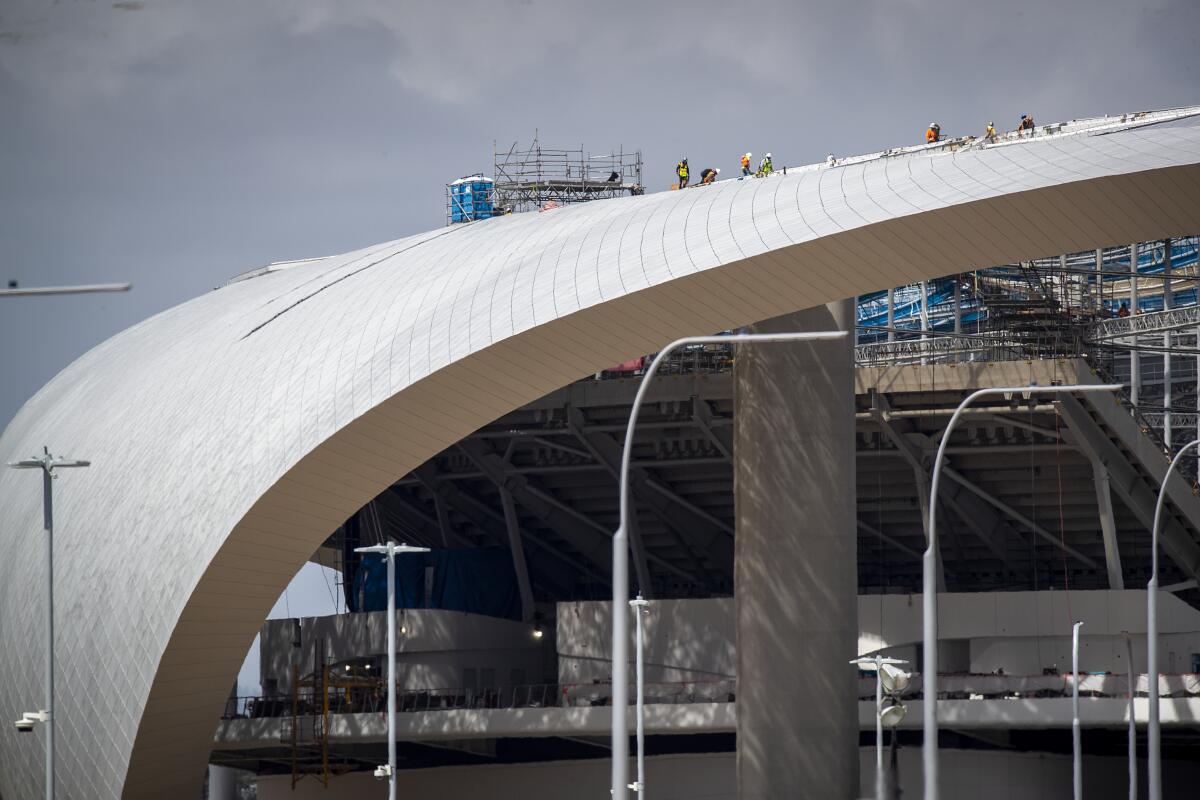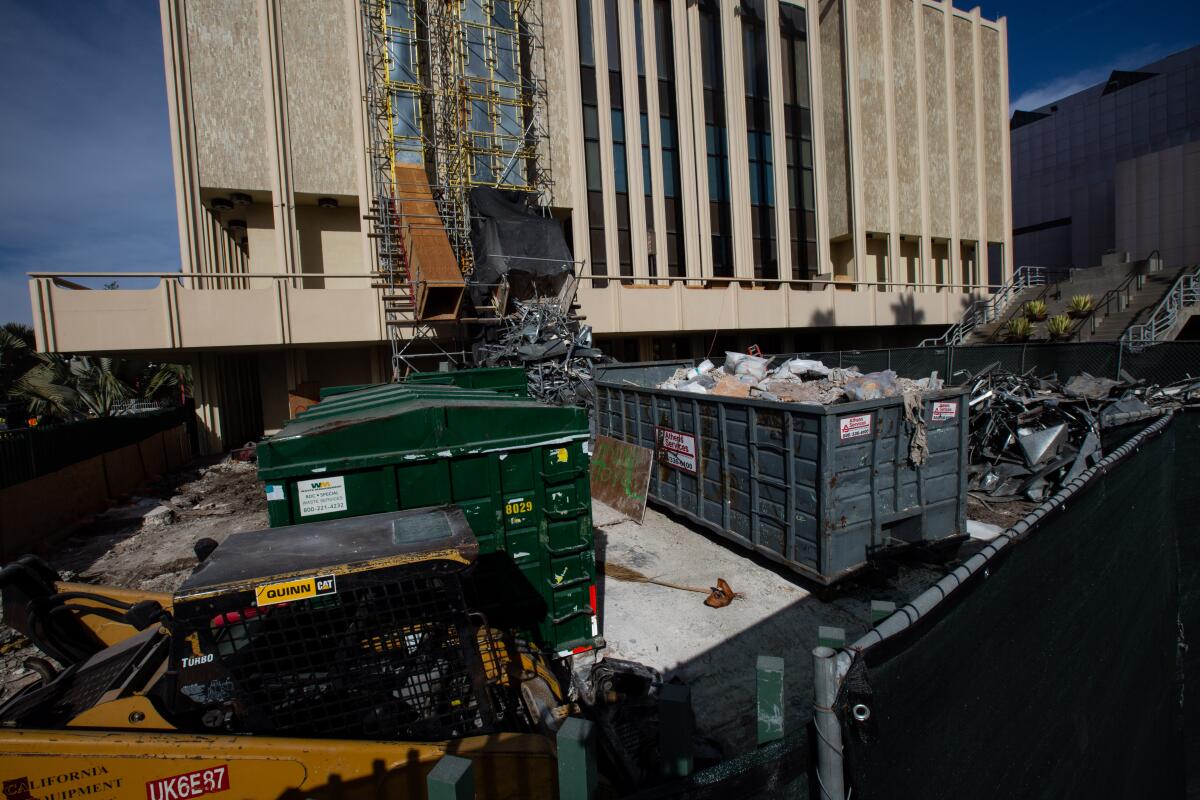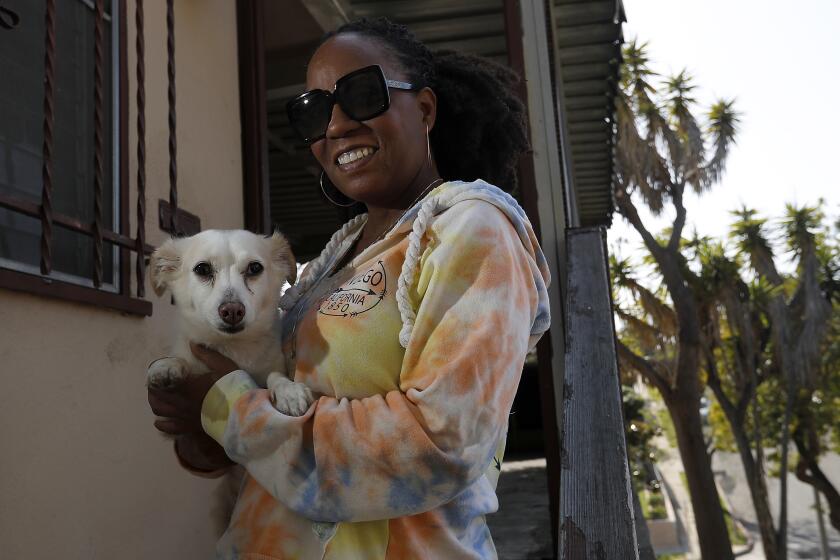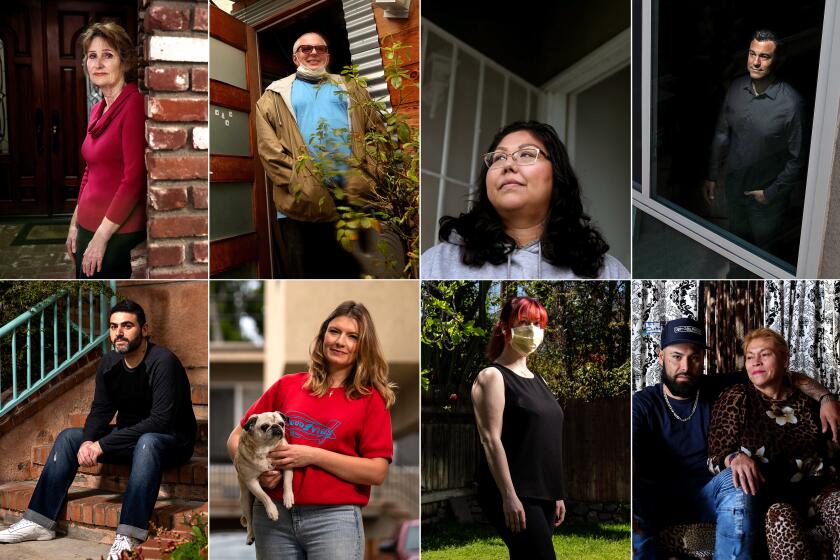L.A. hunkered down. But it hasn’t stopped building mansions, stadiums and apartments

The sounds of electric saws and hammering filled a narrow street in Pacific Palisades on a recent morning.
Crews wearing protective masks worked on the roof and patio of a sprawling home under construction on the corner. Building permits show it will be about 17,000 square feet and include a sport court, swimming pool and a 1,500-square-foot auxiliary residence.
On a nearby lot, workers scurried around the dirt yard and scaffolding of another imposing home underway. And across the street, excavation continued on the basement for a planned “resort-inspired” home with two swimming pools that’s on the market for $14.8 million.
The coronavirus outbreak has left millions ordered to stay home, emptied highways and spurred record unemployment filings. But construction projects of every shape and size — deemed essential by the state and allowed to proceed by Los Angeles — have continued across the area.
That work includes signature developments such as SoFi Stadium in Inglewood and the Lucas Museum of Narrative Art in Exposition Park, as well as apartment buildings, fast-food restaurants, medical facilities, mixed-use projects, retail space and single-family homes.
Industry and labor officials say the lack of housing in the region and a need for sustained employment justify the exemption, even though workers on several large projects have tested positive for COVID-19, the disease caused by the coronavirus. It’s unclear where they contracted the virus.
The housing market has taken a hit as the coronavirus has spread. However, some buyers are still moving forward.
“It’s hard to shelter in place when you don’t have a place,” said Robbie Hunter, president of the State Building and Construction Trades Council of California, “and that is an important part of what we do.”
Several states, including New York and Washington, stopped or limited construction deemed nonessential in response to the pandemic.
But California Gov. Gavin Newsom’s stay-at-home order last month categorized all construction as essential. Asked this month why California has taken a different approach to construction, Newsom said that the health situation in New York is “very different” from California and that he’s satisfied with the state’s directives for the industry.

That leaves it to cities and other local governments whether to enact tighter restrictions. Six San Francisco Bay Area counties tightened their collective stay-at-home order March 31 to halt most commercial and residential construction. Los Angeles allowed all types of construction to proceed but added requirements for workers to practice social distancing, wear masks that cover their noses and mouths, and be checked for COVID-19 symptoms at job sites.
Mayor Eric Garcetti pledged to close any site that doesn’t follow the safety regulations. Officials said Friday that the city had conducted more than 24,000 inspections and issued 215 citations. Three construction sites were shut down, but the problems have since been fixed and work has resumed.
“Residential and commercial construction are critical to our city, and that work is allowed to continue at a safe physical distance between workers because we desperately need more housing,” the mayor’s office said in a statement in response to questions about why — contrary to the Bay Area — all types of construction are permitted to continue in Los Angeles.
Some residents, hunkered down in their residences because of the stay-at-home order while enduring noise and vibration from nearby job sites, aren’t happy.
The Times spoke with four landlords and four tenants across Los Angeles County to understand how they’re coping with the fallout from the coronavirus.
“Regularly waking up to construction noises at 7 a.m. is jarring enough in normal life, but when you aren’t able to escape it and forced to stay in your home all day, every day, it’s anxiety-inducing and frustrating at best,” Hollywood resident Shannon Green wrote to the L.A. City Council.
The council put off a recent effort to ban construction in residential neighborhoods before 9 a.m. — it’s allowed to start at 7 a.m. on weekdays — after some council members cited the possible effect on construction of affordable housing and the economy.
The continuation of so many projects is, however, raising questions over what should truly be labeled essential.
Stella Grey, a board member of the Doheny Sunset Plaza Neighborhood Assn., said she sees no reason why, during a pandemic, developers should be allowed to build mega-mansions in her Hollywood Hills neighborhood. Once finished, some of the homes languish on the market and in normal times are rented for lavish parties.
She said she worries the work is contributing to the virus’ spread. During breaks, she said, many workers don’t wear their masks and get closer than six feet, particularly when lining up to place orders at food trucks.
On a recent morning, workers in the neighborhood appeared to wear masks. But at times they ventured within six feet of one another.
“We have [new] houses for $40 million, for $25 million,” Grey said. “This construction is not essential. It doesn’t improve any problems the city has and it should not continue.”
Union leaders say construction workers fill a vital role and can navigate the health-related challenges of working during a pandemic because they have been trained since their apprenticeships to closely follow safety rules.
“A lot of it has been designed on the fly, but the system is working and gets modified and improved on a daily basis,” said Ron Miller, executive secretary of the Los Angeles/Orange Counties Building and Construction Trades Council.
Shutting down construction, he said, would put 400,000 union workers and 60,000 apprentices across the state out of work and further burden the deteriorating economy.
“Construction, especially large commercial, infrastructure and industrial projects, has almost an obsession with safety,” said George Gibson Jr., a professor and chair of construction management and engineering at Arizona State University. “I believe that social distancing — which seems to be effective — can occur on construction sites and is happening a lot.”

The new normal means that workers at SoFi Stadium — the future home of the National Football League’s Rams and Chargers — have their temperature checked each day before entering the job site. Everyone wears masks on the project.
Nonessential staff work from home. Extra bathrooms and hand-washing facilities have been added. Workers are told to not linger on-site after their shifts and to stay home if they’re sick. Large signs remind them to stay six feet from one another — not following the distancing protocols is grounds for termination.
But some workers on the project say that’s difficult if they’re doing their jobs correctly. “It just doesn’t work,” an ironworker said, adding that he continues to see workers clumped together.
“Social distancing at work is impossible,” an electrician said. “Reducing [proximity], maybe, but not 100%.”
Two workers at the site have tested positive for COVID-19 in the last month — both are recovering — and workers across several trades have questioned whether it’s necessary for work to continue in the midst of the pandemic.
“This job is in no way essential work,” said a third worker who has been on the project for more than a year and, like the others, spoke on the condition they not be named to avoid retaliation.
What’s not in question is the economic impact of completing the $5-billion stadium, the centerpiece of a 298-acre development that will include shops, restaurants and a hotel. The project has already lifted property values in the surrounding area.
It’s unclear when the stadium will open. The Taylor Swift concert that had been scheduled to christen the venue in late July won’t take place after the singer-songwriter postponed all live appearances until 2021. The next planned event is Kenny Chesney’s Aug. 1 concert. Three other major concerts are scheduled for August and September. The NFL schedule won’t be released until next month, but if games will be played, where they would take place and whether fans will be allowed to attend them is all unclear.
Workers elsewhere have also fallen ill.
The $1-billion Grand Avenue mixed-use development designed by Frank Gehry shut down for four days for deep cleaning this month after a worker tested positive for COVID-19, according to internal emails from the contractor AECOM Tishman that were reviewed by The Times.
“We are the economic engine of the city and for that reason will look to complete the deep cleaning swiftly so that work may safely resume,” the email said.
A spokesman for AECOM Tishman said work resumed April 13 and noted that the project will provide “much needed housing, including 20% affordable housing.”
Following stay-at-home orders due to the coronavirus, Southern California home buyers have pulled sharply back. But prices seem stable for now.
An employee of an insulation company working on the $1.6-billion Los Angeles International Airport midfield satellite concourse contracted COVID-19 last month, according to an email sent to subcontractors on the project. Four construction contractors on Metro projects have tested positive too.
Jack Dennerlein, a professor at Harvard’s School of Public Health who researches worker safety and health, said adding safety protocols such as social distancing on construction sites to prevent the spread of the virus means workers have to quickly adjust to new ways of doing their jobs. That might conflict, for example, with asking co-workers to help lift a heavy object.
“There’s a tension between some of these best safety practices and what we’ve got to do for COVID-19,” he said. “Workers are making decisions every minute about what to prioritize.”
The number of workers involved in large projects presents another challenge.
“Workers change on construction sites,” Dennerlein said. “It’s sort of like a train station. You’re having people come and go on a given day. That will increase your exposure.”
But construction of every variety continues across L.A.

Demolition is underway as part of a $750-million project to build a new main building at the L.A. County Museum of Art. The general contractor for the $1-billion Lucas Museum paused construction for two weeks “to assess how best to provide an environment that is as safe as possible for the workers,” according to a spokeswoman for the museum. Work has restarted.
Ron Sentchuk, owner-developer of Estates at North Ranch, a new development in Westlake Village, said his team has implemented new requirements for its workers while restricting traffic to and from job sites in the wake of the pandemic.
The 35-plus-acre development is made up of 15 gated residences ranging from mid-5,000 square feet to more than 10,000 square feet. Prices of the second-phase homes, which are under construction, start at about $5 million and run upward of $10 million.
“We’ve closed the gates and manned the gates,” Sentchuk said. “There is someone at the entrance who logs everyone coming in and coming out of the job site and hands out rules regarding COVID-19.”
He said anyone entering a site is handed a list of rules and a mask. Cars are tagged by color in order to identify individuals entering and leaving the development. Air filtration systems are also being installed.
At 2900 Wilshire Blvd., a 24-story apartment tower under construction in Koreatown, it takes longer to get everyone started each day than before the pandemic, but the $300-million project is still on schedule.

The 250 workers’ arrival times are staggered starting at 6:30 a.m. to allow for daily temperature checks and filling out a questionnaire on possible exposure to the virus. The building is now 17 stories tall, and instead of piling into a construction elevator by the dozen, the workers ride up three at a time in order to keep distance from one another.
“We are happy to keep people working who want to work,” said Scott Dobbins, the project’s developer and president of Hankey Investment Co. “We all hear it and think it’s true that housing is critically short. Short of a hospital or medical center, what else would you want done?”
To make that happen requires someone to show up to the job site, day after day, as the pandemic continues.
A letter from the Pasadena-based International Brotherhood of Electrical Workers Local 11 to members in mid-April summed up the tension that results.
“I know many of you struggle with the choice,” Joel Barton, the local’s business manager, wrote. “Do you go to work and run the risk of getting sick; or do you stay home and miss a paycheck? Whatever your decision is about working, you are not to be judged.”
Times staff writers Ryan Kartje and Neal J. Leitereg contributed to this report.












